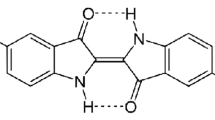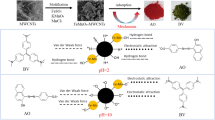Abstract
It is well-known that direct discharges of dye-contaminated wastewaters generated from various industries (i.e., textile, cosmetics and food industries,…) cause severe effects on both aquatic environment and human health. Decontamination of dye-containing wastewaters using nanomaterials-based adsorbents such as carbon nanotubes is regarded as an interesting field of investigation to control these types of pollutants. In this context, a newly prepared ferrocene-modified carbon nanotubes (amFc-MWCNTs) was applied as an adsorbent for the removal of rhodamine B (RhB) dye from aqueous solutions. The structural properties of the hybrid adsorbent were fully characterized using Raman, XPS, EDX, SEM and TEM microscopy. Adsorption isotherms and kinetics of RhB were investigated and multiple models (i.e. Langmuir, Freundlich, Hill,…) were used to fit experimental data. It was found that > 98% of RhB with initial concentration of 10 mg L−1 can be captured within 2 h when using 0.4 g L−1 of amFc-MWCNTs. The adsorption behavior of this nanomaterial fitted well with the Hill isotherm and the pseudo-second-order kinetic model. Moreover, the intra-particle diffusion was identified as the rate-limiting step of the adsorption process. After washing with acetone, regenerated amFc-MWCNTs adsorbent showed good recovery, indicating its reusability and its potential in practical applications.







Similar content being viewed by others
References
Huang Y, Zheng X, Feng S, Guo Z, Liang S (2016) Enhancement of rhodamine B removal by modifying activated carbon developed from Lythrum salicaria L. with pyruvic acid. Colloids Surf A 489:154–162
Beija M, Afonso CAM, Martinho JMG (2009) Synthesis and applications of Rhodamine derivatives as fluorescent probes. Chem Soc Rev 38:2410–2433
Fisher P (1999) Review of using Rhodamine B as a marker for wildlife studies. Wildl Soc Bull 27:318–329
Lewis IL, Patterson RM, McBay HC (1981) The effects of Rhodamine B on the chromosomes of Muntiacus muntjac. Mutat Res Genet Toxicol 88:211–216
Parodi S, Taningher M, Russo P, Pala M, Tamaro M, Monti-Bragadin C (1981) DNA-damaging activity in vivo and bacterial mutagenicity of sixteen aromatic amines and azo-derivatives, as related quantitatively to their carcinogenicity. Carcinogenesis 2:1317–1326
Baslak C, Arslan G, Kusc M, Cengeloglu Y (2016) Removal of Rhodamine B from water by using CdTeSe quantum dot-cellulose membrane composites. RSC Adv 6:18549–18557
Qu J (2008) Research progress of novel adsorption processes in water purification: a review. J Environ Sci 20:1–13
Yagub MT, Sen TK, Afroze S, Ang HM (2014) Dye and its removal from aqueous solution by adsorption: a review. Adv Colloid Interface Sci 209:172–184
Suhas Carrott PJM, Carrott MMLR (2007) Lignin—from natural adsorbent to activated carbon: a review. Bioresource Technol 98:2301–2312
Suhas Gupta VK, Carrott PJM, Singh R, Chaudhary M, Kushwaha S (2016) Cellulose: a review as natural, modified and activated carbon adsorbent. Bioresour Technol 216:1066–1076
Bhattacharyya KG, Gupta SS (2008) Adsorption of a few heavy metals on natural and modified kaolinite and montmorillonite: a review. Adv Colloid Interface Sci 140:114–131
Aditya D, Rohan P, Suresh G (2011) Nano–adsorbents for wastewater treatment: a review. Res J Chem Environ 15:1033–1040
Mohmood I, Lopes CB, Lopes I, Ahmad I, Duarte AC, Pereira E (2013) Nanoscale materials and their use in water contaminants removal–a review. Environ Sci Pollut R 20:1239–1260
Yu JG, Zhao XH, Yang H, Chen XH, Yang Q, Yu LY, Jiang JH, Chen XQ (2014) Aqueous adsorption and removal of organic contaminants by carbon nanotubes. Sci Total Environ 482–483:241–251
Dresselhaus MS, Dresselhaus G, Jorio A (2004) Unusual properties and structure of carbon nanotubes. Annu Rev Mater Res 34:247–278
Oyetade OA, Nyamori VO, Martincigh BS, Jonnalagadda SB (2015) Effectiveness of carbon nanotube–cobalt ferrite nanocomposites for the adsorption of rhodamine B from aqueous solutions. RSC Adv 5:22724–22739
Mohammed MI, Baytak S (2016) Synthesis of bentonite–carbon nanotube nanocomposite and its adsorption of Rhodamine dye from water. Arab J Sci Eng 41:4775–4785
Rabti A, Raouafi N, Merkoçi A (2016) Bio(Sensing) devices based on ferrocene–functionalized graphene and carbon nanotubes. Carbon 108:481–514
Erden PE, Kaçar C, Oztürk F, Kiliç E (2015) Amperometric uric acid biosensor based on poly(vinylferrocene)–gelatin–carboxylated multiwalled carbon nanotube modified glassy carbon electrode. Talanta 134:488–495
Liu J, Qin Y, Li D, Wang T, Liu Y, Wang J, Wang E (2013) Highly sensitive and selective detection of cancer cell with a label–free electrochemical cytosensor. Biosens Bioelectron 41:436–441
Rabti A, Mayorga-Martinez CC, Baptista-Pires L, Raouafi N, Merkoçi A (2016) Ferrocene–functionalized graphene electrode for biosensing applications. Anal Chim Acta 926:28–35
Rabti A, Ben Aoun S, Raouafi N (2016) A sensitive nitrite sensor using an electrode consisting of reduced graphene oxide functionalized with ferrocene. Microchim Acta 183:3111–3117
Singh P, Campidelli S, Giordani S, Bonifazi D, Bianco A, Prato M (2009) Organic functionalisation and characterisation of single-walled carbon nanotubes. Chem Soc Rev 38:2214–2230
Lawrence EJ, Wildgoose GG, Aldous L, Wu YA, Warner JH, Compton RG, McNaughter PD (2011) 3-Aryl-3-(trifluoromethyl)diazirines as versatile photoactivated “linker” molecules for the improved covalent modification of graphitic and carbon nanotube surfaces. Chem Mater 23:3740–3751
Yu L, Mao Y, Qu L (2013) Simple voltammetric determination of Rhodamine B by using the glassy carbon electrode in fruit juice and preserved fruit. Food Anal Methods 6:1665–1670
Saini J, Garg VK, Gupta RK, Kataria N (2017) Removal of Orange G and Rhodamine B dyes from aqueous system using hydrothermally synthesized zinc oxide loaded activated carbon (ZnO–AC). J Environ Chem Eng 5:884–892
Kumar S, Bhanjana G, Jangra K, Dilbaghi N, Umar A (2014) Utilization of carbon nanotubes for the removal of Rhodamine B dye from aqueous solutions. J Nanosci Nanotechnol 14:4331–4336
Langmuir I (1916) The constitution and fundamental properties of solids and liquids. Part I. Solids. J Am Chem Soc 38:2221–2295
Freundlich HMF (1906) Over the Adsorption in Solution. J Phys Chem 57:385–471
Gadagkar SR, Call GB (2015) Computational tools for fitting the Hill equation to dose–response curves. J Pharmacol Toxicol Methods 71:68–76
Cai Q, Turner BD, Sheng D, Sloan S (2015) The kinetics of fluoride sorption by zeolite: effects of cadmium, barium and manganese. J Contam Hydrol 177–178:136–147
Koopal LK, Van Riemsdijk WH, de Wit JCM, Benedetti MF (1994) Analytical isotherm equation for multicomponent adsorption to heterogeneous surfaces. J Colloid Interface Sci 166:51–60
Luo Q, Andrade JD (1998) Cooperative adsorption of proteins onto hydroxyapatite. J Colloid Interface Sci 200:104–113
Ngah WSW, Ariff NFM, Hashim A, Hanafiah MAKM (2010) Malachite green adsorption onto chitosan coated bentonite beads: isotherms, kinetics and mechanism. Clean-Soil, Air, Water 38:394–400
Kerkez O, Bayazit SS (2014) Magnetite decorated multi-walled carbon nanotubes for removal of toxic dyes from aqueous solutions. J Nanopart Res 16:2431
Yu F, Chen J, Yang M, Zhou L, Jin L, Su C, Li F, Chen L, Yuan Z, Yu L, Ma J (2012) A facile one-pot method for synthesis of low-cost magnetic carbon nanotubes and their applications for dye removal. New J Chem 36:1940–1943
Trivedi HC, Patel VM, Patel RD (1973) Adsorption of cellulose triacetate on calcium silicate. Eur Polym J 9:525–531
Ho YS, McKay G (1999) Pseudo–second order model for sorption processes. Process Biochem 34:451–465
Weber WJ, Morris JC (1963) Kinetics of adsorption on carbon from solution. J Sanit Eng Div 89:31–60
Ma J, Yu F, Zhou L, Jin L, Yang M, Luan J, Tang Y, Fan H, Yuan Z, Chen J (2012) Enhanced adsorptive removal of Methyl Orange and Methylene Blue from aqueous solution by alkali-activated multiwalled carbon nanotubes. ACS Appl Mater Interfaces 4:5749–5760
Acknowledgments
The authors would like to acknowledge the financial support from the Tunisian Ministry of Higher Education and Scientific Research to our laboratory (LCAE-LR99ES15).
Author information
Authors and Affiliations
Corresponding authors
Ethics declarations
Conflict of interest
On behalf of all authors, the corresponding author states that there is no conflict of interest.
Rights and permissions
About this article
Cite this article
Rabti, A., Hannachi, A., Maghraoui-Meherzi, H. et al. Ferrocene–Functionalized Carbon Nanotubes: An Adsorbent for Rhodamine B. Chemistry Africa 2, 113–122 (2019). https://doi.org/10.1007/s42250-018-00031-0
Received:
Accepted:
Published:
Issue Date:
DOI: https://doi.org/10.1007/s42250-018-00031-0




